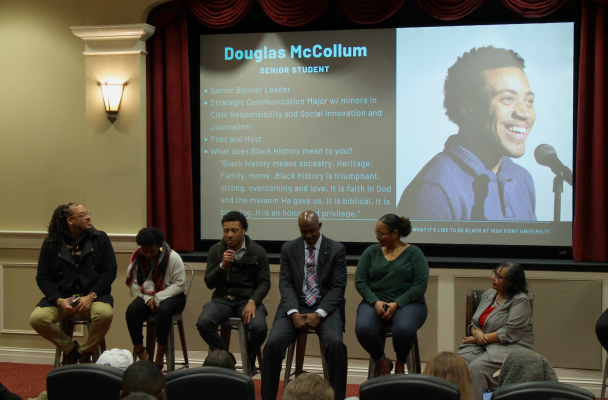‘What it’s like to be Black’ shows the importance of diversity at HPU

Senior Douglas McCollum (third from left) was one of many speakers at “What It’s Like to be Black” who shared his thoughts with the HPU community. Photo submitted
By Delaney Geraghty
Staff Writer
On Feb. 27, students, faculty and community members alike piled into the NQSC Screening Room to participate in an evening of conversation and solidarity at the end of Black History Month. There wasn’t an open seat in the room – many attendees had to sit on the floor or stand along the walls for the entirety of the event. The night’s dialogue centered around one essential question: what’s it like to be African-American at High Point University, a predominantly white institution?
The event, titled “What It’s Like to Be Black At High Point University,” was jointly hosted by Black Cultural Awareness and the Black Student Union. It featured a student-produced documentary screening and subsequent discussion panel composed of various HPU community members. The panel included Ms. Nita Williams, Dr. Dandrielle Lewis, Dr. Doug Hall, Professor Gregory Drumwright, senior Douglas McCollum and junior Helen Barnett.
The 31-minute documentary highlighted the unique challenges that African-Americans face at HPU, depicting a wide array of personal stories and perspectives from black students and faculty. After the screening, the six-member panel took to the floor to answer questions from both the BSU/BCA hosts and the audience. The discussion covered everything from the moment each member realized they were living as a black person in America to how fellow HPU students and faculty can help to improve minority experiences.
“With having such a small population of us on campus, it’s hard to get our voice out there,” said Kennedy Jackson, the vice president of BCA and one of the event’s lead organizers. She emphasized the importance of providing an outlet for minority students to share their experiences with each other and with the rest of the campus community.
Rather than calling these outlets “safe spaces,” she describes them as “rave spaces,” opting for a bolder connotation than the original term affords.
“[Safe spaces] sound like you’re closing yourself off so you can feel comfortable,” Jackson said. “In a rave space, you should still feel uncomfortable, but you should be able to share what you feel.”
And everyone participating did indeed share how they felt, strongly and unforgivingly. From those featured in the documentary, to the panel members, to general attendees in the audience, every person who contributed spoke their mind and engaged in an important conversation about race and representation at a predominantly white institution.
“I think it’s important for those events to happen just so the black community can sit down and learn with each other,” said Kayla Quick, the president and founder of BSU and another lead organizer of the event. “There aren’t many of us on campus, so we need spaces like that, which allow us to be ourselves without restrictions of other people.”
In an effort to promote and strengthen the relationship among the black student body, Quick founded the BSU chapter in the spring of 2018.
“We’re strong, but we can always be stronger,” she said of the HPU’s black community. “It kind of gets discouraging because there’s not a lot of people that look like us, so you don’t really know that you’re making that big of an impact when you are speaking out.”
Echoing Quick’s sentiments, the panel members also emphasized the importance of speaking out and establishing a minority presence at HPU. But they also stressed the fact that students, faculty and administration of all races have to be involved to truly curate a diverse and inclusive campus culture.
Quick said that there needs to be a more open dialogue about race among the student body, even though it can be an uncomfortable topic for some people. She also spoke about the steps the administration should take to uplift and support minority voices at HPU, including making efforts to bring in more students and faculty of color, and attending and promoting black cultural events.
“Seeing the people who are in those higher positions at these panels and at these events, it makes students feel supported and that our needs are being heard,” Quick said.
Jackson also agreed that the administration should work towards a more diverse campus environment.
“Diversity comes with inclusion, and people need to understand that,” she said, adding that the school currently lacks a permanent space specifically for minority communities. “There should be a room or building, or just a space, for people of color or people who are part of these minority groups.”
Both Jackson and Quick expressed gratitude for the opportunity to hold this event and for the positive attendance and reception it received. They’re hopeful that this inaugural year of BCA and BSU collaboration will set the stage for continuing efforts to strengthen the black community at HPU.
“We had black students, black faculty, white students and white faculty all in one space willing to listen,” Quick said. “I’m just grateful that I was able to bring that together to where it can be expanded in the future.”